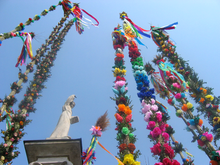Easter palm
Easter palms are palm branches attached to long wooden sticks that are carried by Catholics to the palm procession on Palm Sunday . Making Easter palms is one of the traditional customs of Easter . They are usually made from locally available, suitable branches and decorated and adorned according to local custom. Easter palms are particularly widespread in Poland , but they can also be found in the Black Forest , Swabia , Austria , Eastern Europe , France , Spain and the Netherlands .
origin
The tradition of the Easter palms is based on the entry into Jerusalem described in the Bible , when Jesus Christ rode into Jerusalem on a donkey and was cheered by the people. The people scattered palm fronds on the path of the arriving Christ ( Mk 11.1–11 EU ).
regional customs
Easter palms are made on Palm Sunday, the beginning of Holy Week . For this purpose, willow twigs (the pussy willows are also called "palm kittens") or branch bundles known locally as palm bushes are attached to long wooden poles. In addition to willow, juniper , boxwood and other green branches are also used. These are also decorated with numerous colorful flowers, leaves, grasses, paper flowers and ribbons. In the Netherlands, the Easter palms are also often hung with animal figures and all kinds of pastries and sweets. Spanish Easter palms often consist of real palm fronds due to the native vegetation.
Easter palms are considered a protection against misfortunes and diseases. Their size should have a positive influence on the life expectancy of the builder. In some rural regions of Poland, crosses are made from the Easter palms, which are placed on farms on Good Friday and symbolize health and good harvests.
Others

A competition has been held in Lipnica Murowana , Poland , since 1958 to select the largest Easter palm. Some of the palm trees made are over 30 meters high and weigh up to 80 kilograms. In 2011, the largest Easter palm to date was identified with a length of 35.10 meters. Easter palm competitions are also held in other Polish towns.
The Ethnographic Museum in Krakow houses a collection of over 250 Easter palms. Much of the collection comes from the Vilnius area from the first half of the 20th century . The oldest palm dates from 1914. Other specimens come from the regions of Gdansk , Krakow, Wroclaw and the rest of Poland.
Historically, in some German regions, for example in Lower Saxony , the buds of willow, poplar , alder and similar trees were called palms . If the kittens sprouted directly at Easter, they were also called Easter palms.
Web links
Individual evidence
- ↑ a b From Easter in Poland and the meaning of the Easter palm. info-polen.com, April 5, 2007, accessed March 24, 2015 .
- ^ A b Barbara Kästner: Proposal for the creation of a women's group on the topic: Palm Sunday. Ev.-Luth. Regional Church of Saxony (Ed.)
- ↑ a b Katja Elflein: Poland Easter 2011 - Events, manners and customs. polen-netz.de, April 5, 2011, accessed on March 24, 2015 .
- ↑ a b c Municipal administration Lipnica Murowana: The Easter palms of Lipnica Murowana. Poland Travel, accessed on March 24, 2015 .
- ↑ With Easter palms. In: Badische Zeitung , edition of April 2, 2012 ( online ).
- ↑ Małgorzata Oleszkiewicz: Palma wielkanocna. (No longer available online.) Krakow Ethnographic Museum, archived from the original on April 2, 2015 ; Retrieved March 25, 2015 (Polish). Info: The archive link was inserted automatically and has not yet been checked. Please check the original and archive link according to the instructions and then remove this notice.
- ^ Johann Georg Krünitz : Economic Encyclopedia . tape 105 , p. 568 ( online ).
